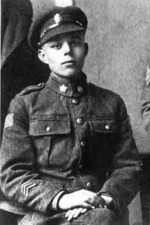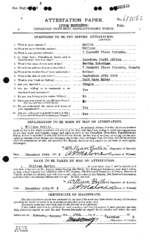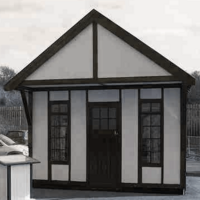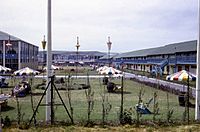Billy Butlin facts for kids
Quick facts for kids
Sir
Billy Butlin
|
|
|---|---|
 |
|
| Born |
William Heygate Edmund Colborne Butlin
29 September 1899 |
| Died | 12 June 1980 (aged 80) Blair Adam House, Jersey
|
| Resting place | Saint John, Jersey |
| Nationality | United Kingdom |
| Organization | Butlins |
| Known for | Holiday camps |
| Spouse(s) | Dorothy Cheriton (1925–1958) Norah Faith Cheriton (1958–1975) Sheila Devine (1975–1980) |
| Signature | |
Sir William Heygate Edmund Colborne Butlin (29 September 1899 – 12 June 1980) was a famous businessman. He is best known for creating the British holiday camp. While other holiday camps existed before him, Butlin turned them into a huge business. He made them a very important part of British culture.
Billy Butlin was born in Cape Town, South Africa. His parents separated when he was young. He moved back to England with his mother. For five years, he traveled with his grandmother's family fair. This taught him about business and entertainment. When he was twelve, his mother moved to Canada. He joined her there two years later.
In Canada, Butlin found school difficult. He soon left to work at a department store called Eaton's. During World War I, he joined the Canadian Army as a bugler. After the war, Butlin returned to England with only £5. He used £4 to rent a stall at his uncle's fair. He found that if he made it easier for customers to win, more people would play. He quickly became successful. Soon, he had many stalls and even bought his own fairground rides. By 1927, he opened a permanent fairground in Skegness.
Over the next 10 years, Butlin grew his fairground business. He had an idea to offer places for people to stay at his Skegness site. His first holiday camp opened in Skegness in 1936. A second camp opened in Clacton two years later. Plans for a third camp in Filey were stopped by World War II. Butlin used the war to his advantage. He convinced the government to finish the Filey Holiday Camp. He also had two more camps built in Ayr and Pwllheli. These were used as training camps during the war. After the war, he got them back. In the years after the war, Butlin opened four more camps. These were in Mosney, Bognor Regis, Minehead, and Barry Island. He also bought hotels in Blackpool, Saltdean, and Cliftonville.
Billy Butlin's grave is in Jersey.
Contents
Early Life and Adventures
William Heygate Edmund Colborne Butlin was born on September 29, 1899. This was in the Cape Colony, which is now part of South Africa. His father was William Colborne Butlin, and his mother was Bertha Cassandra Hill. His mother came from a family of traveling showmen. His parents moved to South Africa. His father opened a bicycle shop. Billy had a younger brother named Harry John. When his parents' marriage ended, his mother returned to England with her children. Sadly, Harry died soon after from polio.
In his autobiography, Butlin wrote that his mother remarried and moved to Canada around 1910. For two years, Billy lived with a widow in Bristol. In 1913, his mother came back to England and married Charles Robotham.
Butlin's mother and stepfather then asked him to join them in Toronto, Canada. He went, but he was not happy at school. He was made fun of for his English accent. He left school at age 14. He then worked as a messenger at Eaton's, a big department store. Working there, he got to visit their summer camp. This was his first experience of a real holiday. Later, he moved to Eaton's advertising department. He drew adverts and studied at night school.
In 1915, during World War I, Butlin joined the Canadian Army. He wanted to be a bugler. His papers said he was born in 1898, not 1899. This made him old enough to join at 15. The papers also said he was a "Suit Case Maker." He was sent to the 170th (Mississauga Horse) Battalion.
Before going to Europe, Butlin moved to the 216th (Bantams) Battalion. He was sent to England, then to France. In France, his group fought in big battles like Ypres and Arras. Butlin served as a stretcher bearer, helping injured soldiers.
After the war, Butlin returned to England on a cattle ship. He had only £5. He went to Bridgwater, Somerset, where his uncle, Marshall Hill, was a showman. He bought a hoopla stall from his uncle. Butlin made a small change to his hoopla game. He made it easier for people to win. This meant he earned less per customer, but many more people played. So, he made more money overall. He moved to London and set up a successful stall. He became so successful that he brought his mother back to the UK from Canada.
Building the Butlin's Empire
Funfairs and Amusement Parks
For the next few years, Butlin traveled with the Hills Travelling Fair. He left his mother to manage his stall in London. Soon, he had his own traveling fair. In 1925, he opened some permanent stalls in Barry Island, Wales. In 1927, he rented land in the seaside town of Skegness. Here, he built an amusement park. It had hoopla stalls, a tower slide, a haunted house, and a scenic railway. In 1928, Butlin got the special right to sell dodgem cars in Europe. His park in Skegness had the first dodgems in Britain. Other showmen bought dodgems from him. His business in Skegness kept growing. By 1930, it even had a zoo with lions and zebras.
Butlin opened a similar fairground in 1932 in Bognor Regis. In 1933, he opened a zoo nearby with polar bears and kangaroos. Around the same time, he opened an amusement park in Littlehampton, called Butlin's Park.
By the 1930s, Butlin had amusement parks in many places. These included Mablethorpe, Hayling Island, Felixstowe, Southsea, and the Isle of Man. He also ran winter fairs in big cities like Edinburgh and Glasgow. By 1935, most of his parks had zoos, which brought in more money.
Butlin's funfair business continued to grow after the war. In 1938, he got the only contract to provide amusements for the Empire Exhibition in Glasgow. After the war, he opened more amusement parks, like one in Sheerness.
The First Holiday Camps
Butlin had a special idea for a holiday camp. He had seen how some landladies would make families leave their rooms between meals, even in bad weather. Butlin wanted to create a holiday place where people could stay on site. It would also offer entertainment all day long.
He opened his first Butlin's camp near Skegness on April 11, 1936. It was opened by Amy Johnson, a famous pilot. An advertisement in the Daily Express announced the camp's opening. It invited people to book a week's holiday. The ad offered three meals a day and free entertainment. A week's stay cost between 35 shillings and £3. When the camp opened, Butlin noticed his guests were not joining in the activities. They seemed bored. He asked Norman Bradford, an engineer, to entertain them. Norman did this with jokes and games. By the end of the night, the camp was lively. This was the start of the famous Butlin's atmosphere. Norman Bradford became the first of Butlin's Redcoats. Butlin decided he needed many more people like Norman to entertain guests.
Butlin opened his second camp in Clacton-on-Sea in Essex in 1938. The local council and hotels were against the idea at first. To convince them, Butlin took council members to Skegness. They saw how much people enjoyed the camp there. The council members were won over when they learned that local shops in Skegness also benefited from the campers. Once approved, construction began, and the Clacton camp opened in 1938.
On January 30, 1937, Butlin turned his business into a company called "Butlin's Ltd." He did this to raise money for his new camps. On February 8, 1937, the company offered shares to the public. All the shares sold out in just five minutes!
World War II and Beyond
When World War II began, the Clacton and Skegness camps were taken over by the military. They were used as training camps. The government needed more camps, so they asked Butlin to build them. Butlin agreed, but only if he could buy the sites back after the war. The government said yes. So, Filey (1945), Pwllheli, and Ayr (both 1947) opened as holiday camps after the war.
During the war, many of Butlin's camps were used by the Royal Navy. Skegness became a training base for sailors. Pwllheli and Ayr also became naval training centers. Clacton was used as a training site for the Royal Pioneer Corps.
Butlin was also asked by the government to help improve spirits among workers in factories. He visited a factory and saw that the workers felt like they were in a prison. Using his experience from holiday camps, Butlin created activities and entertainment to boost their morale. He was then made Director General of Hostels.
In this role, Butlin brought games and entertainment to the factory workers. These included games, plays, and movies. He encouraged workers to take holidays at home. He arranged traveling fairs to visit towns during their "holiday week."
For his work during the war, Butlin was given the MBE award in 1944.
Expanding After the War
After the war, many holiday camps in Britain were damaged. Butlin's camps, except for Clacton, were mostly fine. Even Clacton reopened in early 1946. In the years after the war, Butlin saw chances to expand overseas. He opened camps in Mosney, Ireland, in 1948, and on Grand Bahama in 1949.
The Mosney camp was similar to his successful camps in Britain. However, some people in Ireland were worried about this "English idea." Butlin made sure the camp had a Catholic chapel with a priest. He also promised that Irish people would get priority for bookings. The camp opened successfully in July 1948. It operated as a Butlin's camp until the early 1980s.
Butlin had a bigger plan for The Bahamas in 1946. He saw a chance for a camp in a warmer climate. He bought land in Grand Bahama. He also bought hotels in Bermuda and Nassau. The camp was supposed to open on New Year's Day 1950. It cost a lot of money to build. It opened in late 1949, but it was not fully finished. American tourists were not used to the idea of holiday camps. Butlin needed more money to finish it. He eventually sold the hotels. By November 1950, the company for the Caribbean resort was closed down. Butlin decided to focus his efforts back in Europe. In the late 1940s, Butlin also started buying hotels in places like Saltdean, Blackpool, and Cliftonville.
More Camps and Retirement
In the 1960s, Butlin built new camps. These were in Bognor Regis (opened 1960), Minehead (1962), and Barry Island (1966). Barry Island was part of Butlin's until the 1980s. Bognor and Minehead are still Butlin's camps today.
On July 2, 1960, Butlin planned to open his Bognor camp. But it was not ready because of flooding. Butlin offered guests a choice. They could go to the Clacton camp, or stay and help finish building the Bognor camp. Many chose to stay and help. They received a free bottle of champagne as a thank you. Once opened, the camp became very popular. It could hold about 5,000 campers and 5,000 daily visitors.
In the winter of 1961, Butlin started building his camp in Minehead. It opened to the public on May 26, 1962. It cost £2 million to build. Over the next ten years, more attractions were added. These included a miniature railway in 1964, chairlifts in 1965, and a monorail in 1967.
Butlin's idea for holiday camps came from a trip to Barry Island when he was younger. His landlady had locked him out of his B&B all day. He finally decided to build his last and smallest camp there in 1965. Butlin rented land at Nell's Point, Barry Island, in 1966. Construction began in the winter. It opened to campers on June 18, 1966. Butlin retired in 1969. The Barry Island camp was the last one opened under his management.
Later Life and Legacy
Butlin lived in nice homes in London for many years. In 1947, he bought Dane Court in Hampstead. He also served on the board of directors for Belle Vue Stadium. Butlin sold Dane Court in 1951 and moved to a property in Grosvenor Square.
Butlin retired in 1969. He passed the company to his son, Bobby. However, a company tried to take over Butlin's in November 1969. Butlin came out of retirement to help as a "consultant." With his father's help, Bobby stopped the takeover. Butlin then retired again. In 1972, another company, the Rank Organisation, bought Butlin's for £43 million. Both Butlin and his son agreed to the sale.
Butlin's retirement was also due to financial reasons. His accountant told him that his taxes would be very high. So, Butlin decided to move from London. He became a permanent resident in Blair Adam House, Saint John, on the island of Jersey. Jersey had a lower tax rate. He lived in Jersey until he died on June 12, 1980, at age 80. He is buried in St John parish. His grave is shaped like a double bed.
Butlin was very active in charity work. He worked with groups like the Grand Order of Water Rats and the Variety Club of Great Britain. In 1963, he set up the Bill Butlin charitable trust. In 1966, he gave £100,000 to a trust to help police officers who were hurt or killed on duty. This fund grew to over £1 million with public support. For his contributions, he received many honors. A type of rose was named after him. He was also made a knight in 1964, becoming "Sir Billy Butlin." In 1960, he won the Carl Alan award for his help in dance.
Family Life
Butlin stayed close to his mother. He followed her to Canada and brought her back to the UK. She died in 1934, before she saw his first holiday camp.
In the 1920s, Butlin met Doris "Dolly" Mabel Cheriton. Her family owned a fish and chip shop. They married in 1927. Their marriage ended in the early 1930s. Butlin then fell in love with Norah Faith Cheriton, who was Dolly's niece. Dolly refused to divorce him. So, Butlin and Norah could not marry until Dolly died in 1958. Butlin was surprised on his wedding day in 1959 for the TV show This Is Your Life. This second marriage lasted only a few months. Butlin had fallen in love with Sheila Edwina Devine. This time, Norah refused to divorce him. In 1975, divorce laws changed. Butlin was able to divorce Norah and marry Sheila. He stayed with Sheila until he died.
Butlin had two sons and four daughters from his marriages. His son Robert took over the company from 1968 to 1984. He died in 2008. His daughter Jacquie lives on Jersey and runs a shop. His daughter Cherie is an actress.
Images for kids








